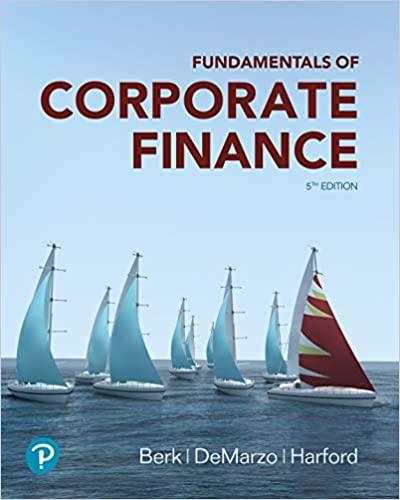
The Current Stock Price EPS (TTM) Number of Shares Outstanding (Million) Industry PE Ratio $148.36 5.63 2,684 26.1 Revenue Growth Rate (5Y) 2 Discounted Cash Flow Method Year 1 Year 2 EBIT/Sales 0.05% 0.07% Tax Rate 0.16% 0.93% Property, Plant & Equipment sales 0.50% 0.50% Depreciation/Property, plant & Equipment 0.10% 0.10% Net Working capital/Sales 0.50% 0.20% Year 3 0.08% 0.15% 0.51% 0.17% 0.18% AVG. 0.067% 0.413% 0.504% 0.122% 0.294% 1. To determine the stock value using the discounted cash flow method: 1. Forecast the free cash flows. Start by using the historical data from the financial statements downloaded from Morningstar to compute the three-year average of the following ratios: 1. EBIT/Sales 2. Tax Rate (income tax expense/income before sales) 3. Property, plant & equipment/Sales 4. Depreciation/property, plant & equipment 5. Net working capital/sales 2. Create an empty timeline for the next five years 3. Forecast future sales based on the most recent year's total revenue growing at the LT growth rate (5Y average) from Reuters for the first five years of the forecast. 4. Use the average ratios from step 5. a. above to forecast EBIT, property plant & equipment, depreciation, and net working capital for the next five years. 5. Forecast the the free cash flow for the next five years. 6. Determine the horizon enterprise value for year 5 using a long-term growth rate of 4% and a cost of capital of 11% for JNJ. 7. Determine the enterprise value of the firm as the present value of the free cash flows. 8. Determine the stock price. Note: your enterprise value is in thousands of dollars and the number of shares outstanding is in billions. 2. To calculate an estimate of the JNJ price based on a comparable P/E Ratio, multiply the industry average P/E ratio by JNJ EPS. 3. Compare the stock values from both methods to the actual stock price. The Current Stock Price EPS (TTM) Number of Shares Outstanding (Million) Industry PE Ratio $148.36 5.63 2,684 26.1 Revenue Growth Rate (5Y) 2 Discounted Cash Flow Method Year 1 Year 2 EBIT/Sales 0.05% 0.07% Tax Rate 0.16% 0.93% Property, Plant & Equipment sales 0.50% 0.50% Depreciation/Property, plant & Equipment 0.10% 0.10% Net Working capital/Sales 0.50% 0.20% Year 3 0.08% 0.15% 0.51% 0.17% 0.18% AVG. 0.067% 0.413% 0.504% 0.122% 0.294% 1. To determine the stock value using the discounted cash flow method: 1. Forecast the free cash flows. Start by using the historical data from the financial statements downloaded from Morningstar to compute the three-year average of the following ratios: 1. EBIT/Sales 2. Tax Rate (income tax expense/income before sales) 3. Property, plant & equipment/Sales 4. Depreciation/property, plant & equipment 5. Net working capital/sales 2. Create an empty timeline for the next five years 3. Forecast future sales based on the most recent year's total revenue growing at the LT growth rate (5Y average) from Reuters for the first five years of the forecast. 4. Use the average ratios from step 5. a. above to forecast EBIT, property plant & equipment, depreciation, and net working capital for the next five years. 5. Forecast the the free cash flow for the next five years. 6. Determine the horizon enterprise value for year 5 using a long-term growth rate of 4% and a cost of capital of 11% for JNJ. 7. Determine the enterprise value of the firm as the present value of the free cash flows. 8. Determine the stock price. Note: your enterprise value is in thousands of dollars and the number of shares outstanding is in billions. 2. To calculate an estimate of the JNJ price based on a comparable P/E Ratio, multiply the industry average P/E ratio by JNJ EPS. 3. Compare the stock values from both methods to the actual stock price







